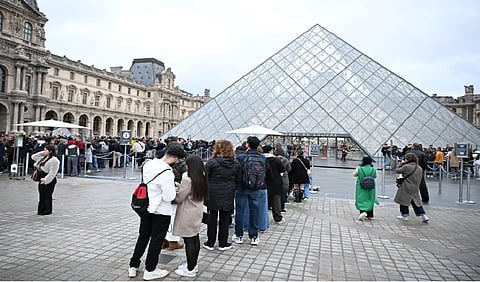

Paris |The Louvre reopened Wednesday morning to crowds under its glass pyramid — even as France reeled from one of the highest-profile museum thefts in living memory just days earlier at the famed museum.
The smash-and-grab that unfolded just 250 metres from the Mona Lisa and has prompted a national reckoning, with some officials comparing the shock to the 2019 burning of Notre-Dame cathedral.
Hundreds queued outside as barriers came down, a visible coda to three days of forensic work, inspections and staff briefings. Tuesday's closure was routine; the museum is normally shut that day.
However, the scene of the heist — the jewel-lined Apollo Room — stayed shuttered.
Authorities say the gang spent less than four minutes inside the Louvre. Using a freight lift wheeled to the Seine-facing facade, the thieves forced a window, smashed two display cases and fled on motorbikes into central Paris.
Alarms drew Louvre agents to the gallery, forcing the intruders to bolt — but the theft was already done.
“We have failed,” Justice Minister Gerald Darmanin said, noting criminals were easily “able to place a freight lift on a public way” — a breach that projects “a very negative image of France.” Eight objects were taken: a sapphire diadem, necklace and single earring from a set linked to 19th-century queens Marie-Amelie and Hortense; an emerald necklace and earrings tied to Empress Marie-Louise, Napoleon Bonaparte's second wife; a reliquary brooch; Empress Eugenie's diamond diadem; and her large corsage-bow brooch — an imperial ensemble of rare craftsmanship.
One piece — the emerald-set imperial crown of Empress Eugenie, with more than 1,300 diamonds — was later found outside the museum, damaged but recoverable.
The haul is valued at about USD 102 million — a “spectacular” figure that fails to capture the works' historical weight, according to Prosecutor Laure Beccuau.
She warned the thieves would be unlikely to realize anything close to that figure if they pry out the gems from their settings or melt the metals. Many curators fear exactly that: that an object's centuries of meaning could be pulverized into anonymous gems for the black market.
On Tuesday, Interior Minister Laurent Nunez said the in-and-out took only minutes; no arrests have been announced and the jewels remain missing.
The investigation is widening. Beccuau said four people have been identified as being at the scene of the heist, with expert analyses underway and about 100 investigators mapping the crew and any accomplices.
The heist has sharpened scrutiny of the Louvre's surveillance — and landed its president-director, Laurence des Cars, on Wednesday before the Senate's culture committee — though top officials have refused to remove her.
The events also collide with a broader museum-security overhaul announced in January by President Emmanuel Macron's government, including a new command post and camera network the culture ministry says are now being rolled out. The heist has serious raised questions about how far those upgrades had progressed.
Security around marquee works remains tight — the Mona Lisa peers out from behind bulletproof glass in a climate-controlled case — but Sunday's theft exposed uneven protections across a collection of more than 33,000 objects. The result, for many French, is a fresh embarrassment at the world's most-visited museum.
The episode also hits a raw nerve at the world's most-visited museum: swelling crowds and stretched staff. A June staff walkout delayed opening over overcrowding and chronic understaffing. Unions say mass tourism leaves too few eyes on too many rooms and creates pressure points where construction zones, freight access and visitor flows intersect.
On Wednesday, the Louvre's other star attractions — from the Venus de Milo to the Winged Victory of Samothrace — were open again.
But the cordoned-off vitrines in the Apollo Room, guarded and empty, told a different story — one of : a breach measured not just in minutes and euros, but in the fragility of a nation's patrimony.
